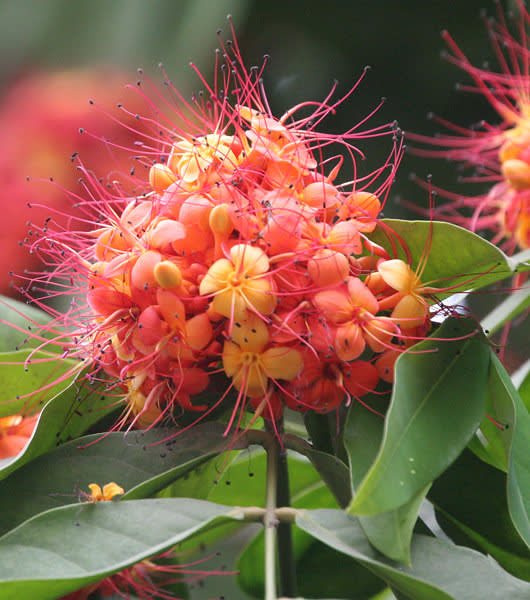Ashoka Tree, Sorrowless Tree, Asoca, Anganapriya, Tamrapallava
Saraca asoca

🌿 Morphology
🌞 Growing conditions
🌍 Origin and family
🌾 Uses
Warning: Despite the care taken in writing this sheet, it is essential to cross-reference sources before using or consuming any plant. When in doubt, consult a qualified professional
Permaculture uses
Saraca asoca is primarily an ornamental tree in permaculture systems. It is not typically used for food production. However, its bark and flowers are used medicinally in traditional Ayurvedic medicine. The tree provides shade and can improve soil health through leaf litter decomposition. Its dense foliage makes it a good windbreak and visual screen.
Permapeople description
An evergreen tree native to India, known for its fragrant orange-red flowers and medicinal properties.
Botanical description
Saraca asoca is an evergreen tree with a rounded crown, typically growing up to 20 meters in height. The bark is dark brown to grey. The leaves are pinnate, with 6-12 leaflets, and are reddish when young, turning green with maturity. The flowers are fragrant and occur in dense clusters, changing color from yellow to orange to red as they mature. The fruits are flattened, oblong pods containing 4-8 seeds.
Companion planting
Information on companion planting for Saraca asoca is limited. As a shade tree, it can be planted alongside understory plants that prefer partial shade. Avoid planting it near plants that require full sun. Its nitrogen-fixing capabilities can benefit plants nearby.
Propagation methods
Saraca asoca can be propagated by seeds, stem cuttings, and air layering. Seed propagation is the most common method, but seeds should be sown fresh as they lose viability quickly. Cuttings can be taken from semi-hardwood in spring or early summer. Air layering is another option for propagating mature trees.
History and traditions
Saraca asoca is considered a sacred tree in Hinduism, Buddhism, and Jainism. It is associated with love, fertility, and healing. In Hindu mythology, it is believed that Sita, the wife of Rama, took refuge under an Ashoka tree when she was abducted by Ravana. The tree is often planted near temples and in home gardens for its religious significance and ornamental value. Traditionally, the bark has been used in Ayurvedic medicine to treat various ailments, including menstrual disorders, uterine problems, and skin diseases.
Usage calendar
Flowering typically occurs from February to April. Fruit pods mature from June to August. Seed sowing is best done in the rainy season (June-September). Pruning can be done after flowering to maintain the tree's shape.
